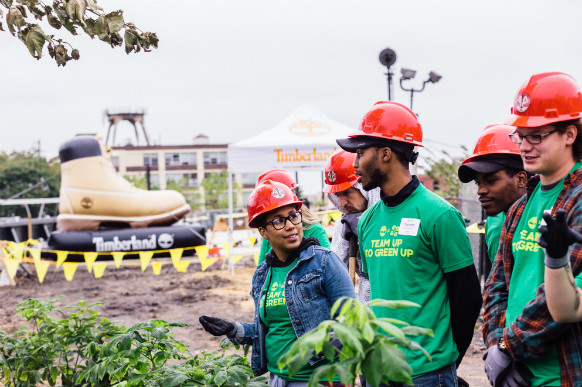In June 2016, 100 employee and business partner volunteers, organized by the outdoor footwear and apparel company Timberland, spent a bright and sunny day reviving the United We Stand Garden in the Mott Haven neighborhood of the Bronx in New York City. In the wake of a damaging fire, what had once been four separate community gardens had become one large lot strewn with trash. The volunteers created 30 raised garden beds from recycled plastic lumber, built pathways to improve garden access, moved a shed, created a space for a mural, and built a performance space and benches. These efforts helped restore the area as a shared community gathering space and garden to support urban agriculture for local residents.
That day, Timberland employees worked side by side with workers from its wholesale partner Journeys, a specialty retailer of branded fashion footwear and accessories. The effort—like other collaborative days of service—not only helped improve a community, but also created lasting goodwill that generated business value for both partners. Partners who serve together get better acquainted, and also tend to develop deeper, more loyal business relationships.

With the aim of advancing its values, Timberland has long worked to protect the outdoors and serve communities where it does business. For 25 years, the company’s Path of Service program has offered employees paid time to serve communities through individual volunteering, as well as global, company-wide service events and business partner events like the one in Mott Haven.
 In 2016, Timberland and its partners, including Journeys, spent a day restoring the United We Stand Garden in New York City.
In 2016, Timberland and its partners, including Journeys, spent a day restoring the United We Stand Garden in New York City.
The company’s Path of Service program launched in 1992 as a way to give every Timberland employee the chance to serve others. It offers employees up to 40 paid volunteer hours annually, and to help employees use their hours, the company sponsors two company-wide days of service each year for its employees worldwide—Earth Day in the spring and Serv-a-palooza in the fall. For these two days, Timberland sponsors and organizes community service projects for teams of local employee volunteers. Time for community service is also often on the agenda at bi-annual sales meetings and other company gatherings. At an upcoming sales meeting, for example, members of the team will spend a half day framing walls for a Habitat for Humanity house. Timberland locations worldwide also host smaller volunteer events periodically throughout the year.
The business power of friendship
As service became integral at Timberland, the company recruited business partners to join events so that it could increase volunteer numbers and maximize community impact. One event that became an enduring example of Timberland’s values in action happened on a beautiful fall day in New York in 2001, when a group of 200 Timberland employees and wholesale partners gathered at the Clara Barton School in the Bronx to serve. The day happened to be September 11 and, as news of the events unfolding became clear to the volunteers, rather than try to flee the city, they actively chose as a team to stay and to serve. Serving together that day connected Timberland with its business partners through shared humanity. And for many, the bonds formed on that fateful day will never be forgotten. The comradery has only grown stronger over the years, as the volunteers continue to serve together at commemorative 9/11 service events.
Experiences like these generate real business value. Members of Timberland’s sales team recognized that the relationships formed with wholesale customers during volunteer projects were different from the relationships they developed in a showroom or over dinner—they tended to generate more loyalty. As a result, there have been times when, for example, boot sales were down-trending, but wholesalers chose to keep Timberland boots on their display wall versus opting for another brand. Timberland’s North American wholesale team now regularly invites representatives of important accounts to service days. The company has also helped create dedicated service events for partners in the partner’s own communities, and has trained partners to source, plan, and execute their own service events. It also began to invite other business partners, including vendors and factory partners, to serve with employee volunteers around the world.
The benefits go both ways. As Nelson Martinez, who previously worked for one of Timberland’s wholesale accounts, says, “Serving with Timberland inspired us to get more engaged in our own community, and since then, we have continued to give back [in partnership with] Timberland but also on our own.” He also believes the experience strengthened the alliance between the two companies. “Serving together dramatically changed our relationship with Timberland,” he says. “It really opened the relationship, since we came to know our partners in a different light.”
 In the fall of 2017, more than 100 volunteers from Timberland and its partners—including Journeys, KicksUSA, and Urban Outfitters—came together to help transform a section of an abandoned railway in Philadelphia into a new city green space.
In the fall of 2017, more than 100 volunteers from Timberland and its partners—including Journeys, KicksUSA, and Urban Outfitters—came together to help transform a section of an abandoned railway in Philadelphia into a new city green space.
Looking forward, Journeys has encouraged its employees to support Timberland’s commitment to green five cities in five years—a way to fulfil Timberland’s outdoor heritage by bringing a touch of the outdoors to underserved communities. More than 100 Journeys employees participated in both the 2016 Mott Haven event, and a 2017 event to spread soil and plant over 800 shrubs on Philadelphia’s new Rail Park. Journeys now plans to partner with Timberland to triple its impact in next fall by supporting events in Chicago, New York, and Los Angeles.
Taking it global
In addition to small-scale community projects in the United States, Timberland has encouraged collaboration on a global scale. In 2017, Timberland invited Vans (a sister brand, as part of VF Corporation) and Patagonia to support its work to re-introduce organic cotton farming to Haiti. The effort builds on Timberland’s successful partnership with Smallholder Farmer’s Alliance (SFA), which planted five million trees in five years in Haiti while improving the lives and livelihoods of smallholder farmers. Initially sparked by a desire to reforest Haiti, the tree-planting project evolved into a self-sustaining program that rewarded farmers’ tree planting and maintenance efforts, and provided them with better-quality crop seed, access to tools, and training to increase the efficiency of their farms. At the end of five years, the farmers had planted close to five million trees, and their crop yields and incomes had increased.
Based on this success, Timberland and the SFA began to test the feasibility of reintroducing cotton to Haiti, a crop that had disappeared 30 years earlier due to policies and politics of the time. The results were promising, and now Timberland is transitioning from being a supporter to a customer. The company is working with the SFA to have the smallholder farmers dedicate some of their land to growing organic cotton.
To ensure the project would be self-sustaining, Timberland agreed to purchase up to a third of the SFA’s cotton supply, contingent on price, quality, and volume. It also helped arrange new relationships with Vans and Patagonia, and is currently reaching out to other potential customers interested in a new and sustainable source of organic cotton with a powerful environmental and social impact story to share with consumers.
Through Timberland’s efforts to engage business partners in community service and its Haiti cotton-farming work, it is proving that acting on company values can benefit communities and strengthen business relationships at the same time.
Support SSIR’s coverage of cross-sector solutions to global challenges.
Help us further the reach of innovative ideas. Donate today.
Read more stories by Colleen Vien.

